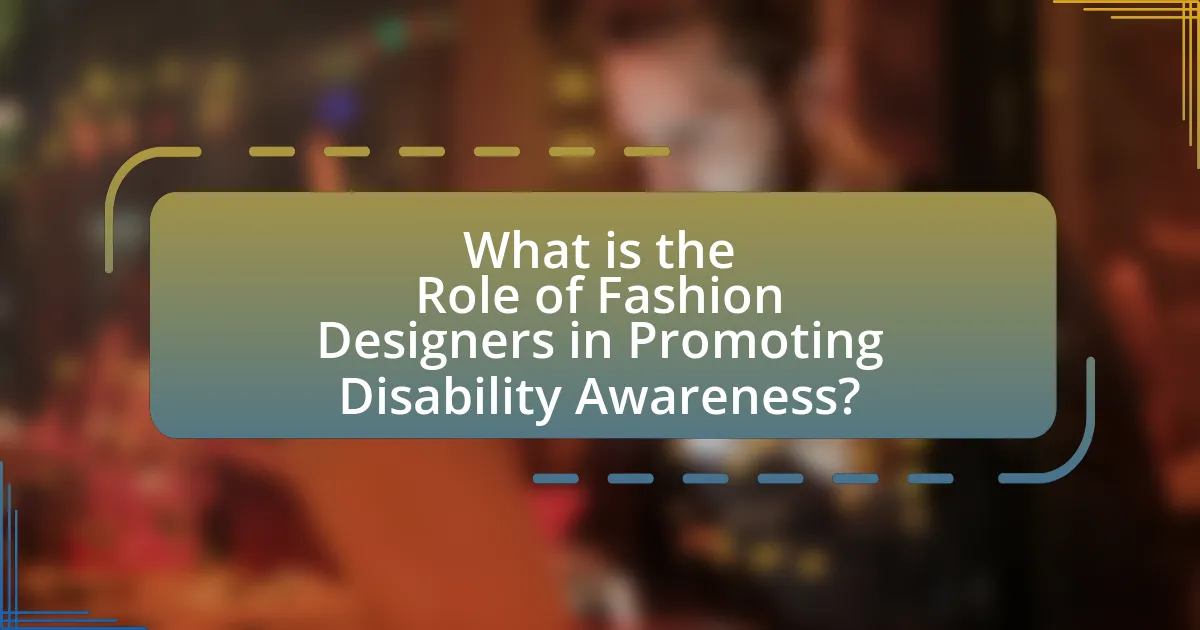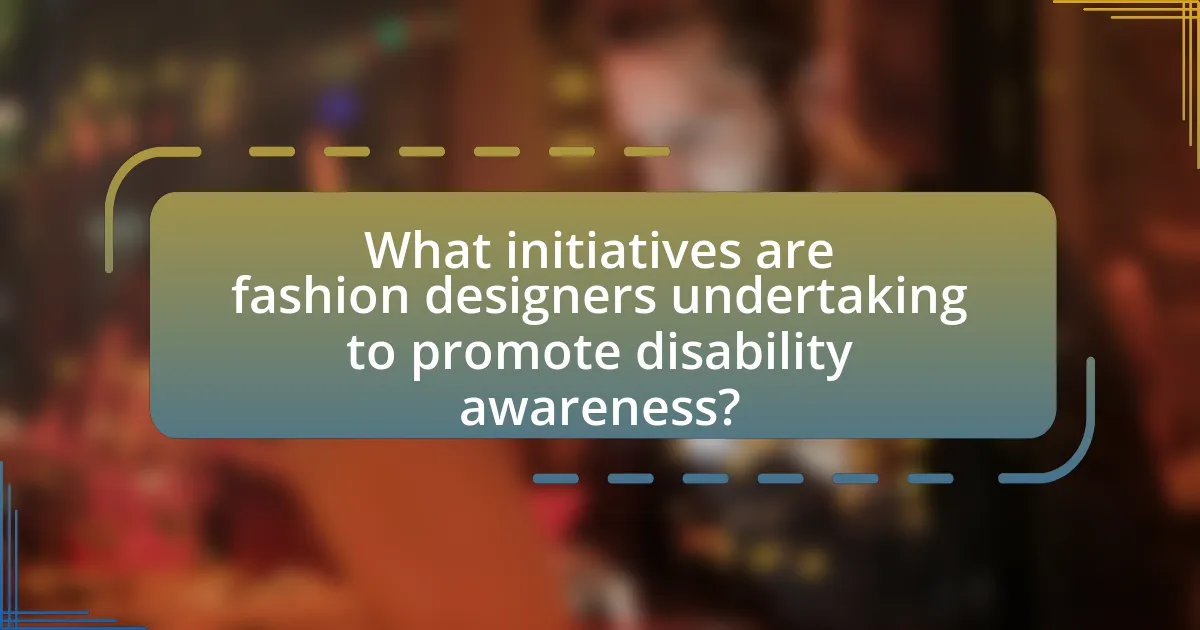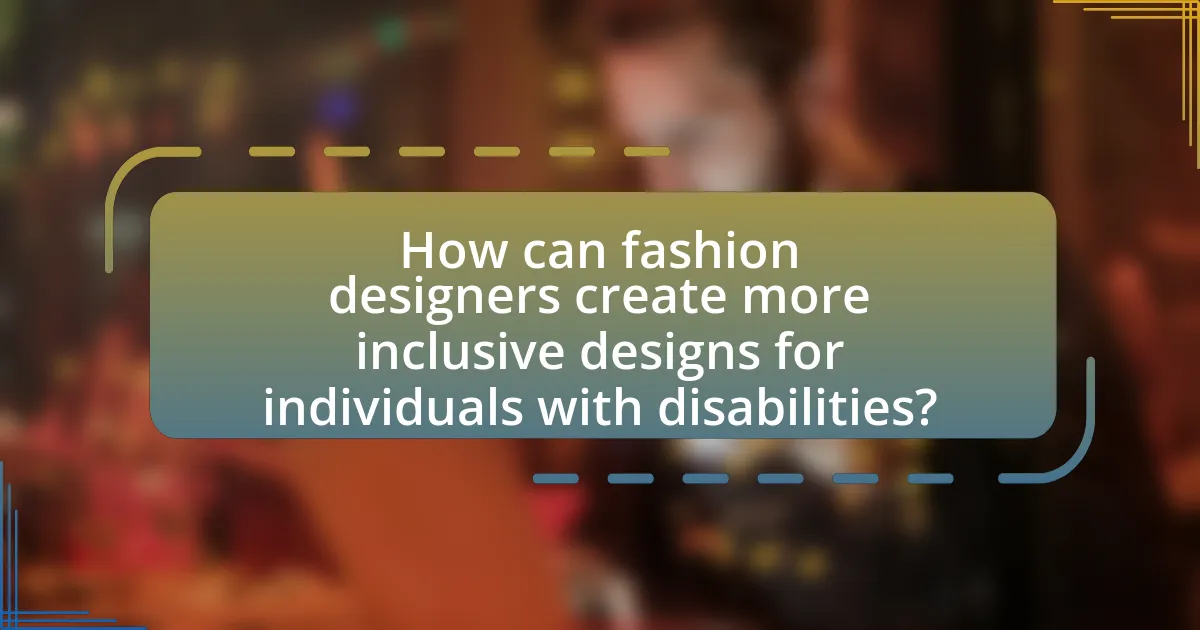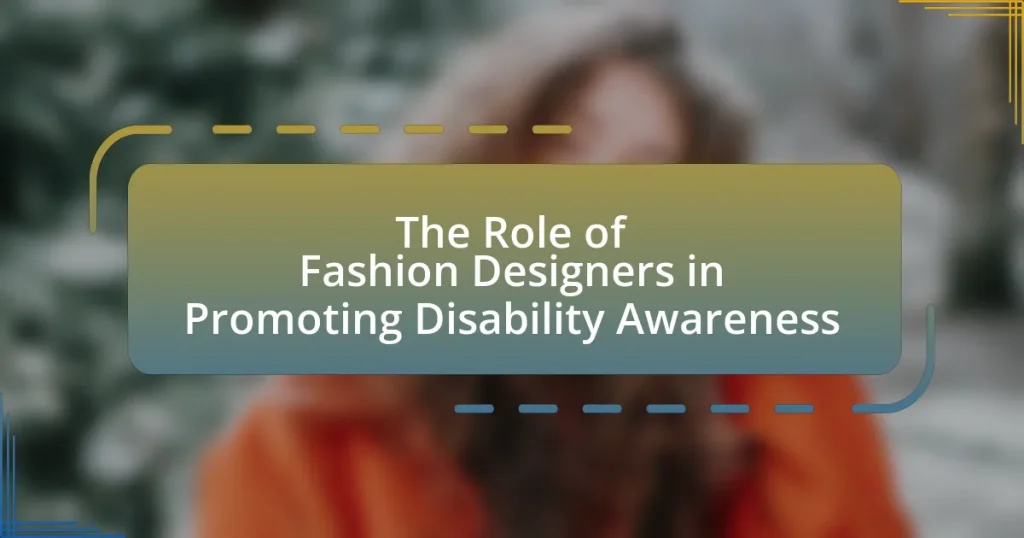Fashion designers play a pivotal role in promoting disability awareness through the creation of inclusive clothing lines that cater to individuals with disabilities. By designing adaptive fashion, they challenge societal norms and enhance visibility for disabled individuals in the industry. The article explores how designers influence public perception, the strategies they employ to raise awareness, and the social implications of inclusive fashion design. It also discusses the challenges faced by designers in promoting disability awareness and highlights successful initiatives and collaborations that have emerged to foster inclusivity in fashion.

What is the Role of Fashion Designers in Promoting Disability Awareness?
Fashion designers play a crucial role in promoting disability awareness by creating inclusive clothing lines that cater to individuals with disabilities. By designing adaptive fashion, they challenge societal norms and stereotypes surrounding disability, making fashion accessible to a broader audience. For instance, brands like Tommy Hilfiger and Zara have launched collections specifically designed for people with disabilities, incorporating features such as magnetic closures and adjustable fits. This not only enhances the visibility of disabled individuals in the fashion industry but also fosters a culture of acceptance and understanding. Through their work, fashion designers can influence public perception and advocate for the rights and representation of people with disabilities.
How do fashion designers influence public perception of disability?
Fashion designers influence public perception of disability by creating inclusive and adaptive clothing lines that challenge stereotypes and promote visibility. By featuring models with disabilities in runway shows and advertising campaigns, designers like Tommy Hilfiger and Rihanna have successfully shifted societal attitudes, demonstrating that fashion can be accessible and diverse. Research indicates that visibility in media, including fashion, significantly impacts public attitudes towards marginalized groups, including individuals with disabilities, fostering greater acceptance and understanding.
What strategies do designers use to raise awareness about disability issues?
Designers raise awareness about disability issues through inclusive design practices, advocacy campaigns, and collaborations with disability organizations. Inclusive design practices ensure that products and fashion are accessible to individuals with disabilities, thereby highlighting their needs and experiences. Advocacy campaigns often utilize social media and public events to engage a broader audience, showcasing the importance of disability representation in fashion. Collaborations with disability organizations provide designers with insights and authentic narratives, ensuring that their work resonates with the community and raises awareness effectively. For instance, the partnership between designers and organizations like the National Disability Rights Network has led to increased visibility of disability issues in mainstream fashion.
How does representation in fashion impact societal attitudes towards disability?
Representation in fashion significantly influences societal attitudes towards disability by challenging stereotypes and promoting inclusivity. When fashion designers incorporate models with disabilities into their campaigns and runway shows, they help normalize the presence of disabled individuals in mainstream culture. This visibility can lead to greater acceptance and understanding, as evidenced by studies showing that diverse representation in media correlates with increased empathy and reduced stigma. For instance, the 2019 study published in the Journal of Fashion Marketing and Management found that inclusive fashion initiatives positively affected public perceptions of disability, demonstrating that representation can reshape societal norms and attitudes.
Why is disability awareness important in the fashion industry?
Disability awareness is important in the fashion industry because it fosters inclusivity and representation for individuals with disabilities. By acknowledging and addressing the unique needs of this demographic, fashion designers can create clothing that is accessible and functional, thereby expanding their market reach. For instance, a study by the Runway of Dreams Foundation highlights that 1 in 5 Americans has a disability, indicating a significant consumer base that is often overlooked. Furthermore, inclusive fashion not only enhances brand loyalty but also promotes social change by challenging stereotypes and encouraging acceptance.
What are the social implications of inclusive fashion design?
Inclusive fashion design promotes social equity by ensuring that individuals of all abilities have access to stylish and functional clothing. This approach challenges societal norms that often marginalize people with disabilities, fostering a sense of belonging and representation in the fashion industry. Research indicates that inclusive design can enhance self-esteem and confidence among individuals with disabilities, as they see themselves reflected in mainstream fashion. Furthermore, inclusive fashion encourages brands to adopt more diverse marketing strategies, which can lead to broader societal acceptance and understanding of disability. By prioritizing inclusivity, fashion designers play a crucial role in reshaping perceptions and advocating for the rights of all individuals, ultimately contributing to a more inclusive society.
How can fashion designers contribute to breaking stereotypes about disability?
Fashion designers can contribute to breaking stereotypes about disability by creating inclusive and adaptive clothing lines that cater to diverse body types and abilities. By prioritizing accessibility in their designs, such as incorporating features like adjustable fits and easy closures, designers challenge the conventional notions of beauty and functionality in fashion. For instance, brands like Tommy Hilfiger and Nike have launched adaptive collections that not only provide stylish options for individuals with disabilities but also promote visibility and representation in the fashion industry. This approach not only empowers individuals with disabilities but also encourages society to rethink and redefine beauty standards, fostering a more inclusive environment.

What initiatives are fashion designers undertaking to promote disability awareness?
Fashion designers are undertaking initiatives such as inclusive fashion shows, adaptive clothing lines, and collaborations with disability advocacy organizations to promote disability awareness. For instance, designers like Tommy Hilfiger have launched adaptive clothing collections that cater to individuals with disabilities, ensuring functionality and style. Additionally, events like the “Runway of Dreams” showcase models with disabilities, raising visibility and challenging stereotypes within the fashion industry. These initiatives not only highlight the importance of inclusivity but also encourage broader societal acceptance and understanding of disability issues.
How are collaborations between designers and disability advocates shaping the industry?
Collaborations between designers and disability advocates are reshaping the fashion industry by fostering inclusive design practices that prioritize accessibility. These partnerships lead to the creation of adaptive clothing lines that cater to the needs of individuals with disabilities, ensuring that fashion is not only stylish but also functional. For instance, brands like Tommy Hilfiger and Zara have launched collections specifically designed for people with disabilities, demonstrating a commitment to inclusivity. Research indicates that 1 in 5 people in the U.S. live with a disability, highlighting the significant market potential for adaptive fashion. By integrating the insights of disability advocates, designers are not only expanding their customer base but also promoting a culture of acceptance and representation within the industry.
What successful campaigns have emerged from these collaborations?
Successful campaigns that have emerged from collaborations between fashion designers and disability advocacy organizations include the “Runway of Dreams” initiative, which promotes adaptive clothing for individuals with disabilities. This campaign has successfully raised awareness and funds, leading to partnerships with major brands like Tommy Hilfiger, which launched a line of adaptive apparel in 2016. Additionally, the “Fashion for All” campaign, which features models with disabilities on the runway, has gained traction, showcasing inclusivity and diversity in fashion. These campaigns have not only highlighted the importance of accessibility in fashion but have also influenced industry standards, as seen in the increased representation of disabled individuals in fashion marketing and events.
How do these initiatives affect the visibility of disabled individuals in fashion?
Initiatives aimed at promoting disability awareness in fashion significantly enhance the visibility of disabled individuals. By featuring models with disabilities in campaigns and runway shows, these initiatives challenge traditional beauty standards and foster inclusivity. For instance, the 2019 New York Fashion Week included models with disabilities, which garnered extensive media coverage and public attention, thereby increasing representation in the industry. This visibility not only empowers disabled individuals but also encourages brands to adopt more inclusive practices, ultimately reshaping societal perceptions of disability in fashion.
What role do fashion shows play in promoting disability awareness?
Fashion shows play a crucial role in promoting disability awareness by showcasing models with disabilities, thereby challenging societal perceptions of beauty and inclusivity. These events provide a platform for designers to highlight adaptive fashion, which caters to the needs of individuals with disabilities, thus fostering a more inclusive industry. For instance, the 2019 New York Fashion Week featured models with disabilities, which garnered significant media attention and sparked conversations about representation in fashion. This visibility not only raises awareness but also encourages brands to consider diverse body types and abilities in their designs, ultimately contributing to a broader cultural shift towards inclusivity.
How can inclusive runway shows change perceptions of disability?
Inclusive runway shows can change perceptions of disability by showcasing diverse models with disabilities, thereby normalizing their presence in mainstream fashion. This visibility challenges stereotypes and promotes the idea that beauty and fashion are inclusive of all body types and abilities. Research indicates that representation in media significantly influences societal attitudes; for instance, a study published in the Journal of Fashion Marketing and Management found that exposure to diverse representations can lead to increased acceptance and understanding of different abilities. By integrating models with disabilities into high-profile fashion events, the industry can foster a more inclusive culture that values diversity and encourages broader societal acceptance.
What are some notable examples of disability-inclusive fashion shows?
Notable examples of disability-inclusive fashion shows include the “FASHIONABLE” show organized by the non-profit organization, “The Fashion Institute of Technology,” which featured models with various disabilities, and the “New York Fashion Week: The Shows” that included models with disabilities, showcasing adaptive clothing lines. Additionally, the “London Fashion Week” has highlighted designers like “Sophie Hines,” who focuses on inclusive designs for people with disabilities. These events demonstrate a growing trend in the fashion industry to embrace diversity and promote awareness of disability through representation on the runway.

How can fashion designers create more inclusive designs for individuals with disabilities?
Fashion designers can create more inclusive designs for individuals with disabilities by incorporating adaptive features that enhance functionality and comfort. This includes using adjustable closures, magnetic fasteners, and stretchable fabrics to accommodate various physical needs. Research indicates that approximately 15% of the global population lives with some form of disability, highlighting the necessity for fashion that caters to this demographic. By collaborating with individuals with disabilities during the design process, designers can gain valuable insights into specific requirements and preferences, ensuring that the final products are both stylish and practical.
What are the key considerations for designing adaptive clothing?
Key considerations for designing adaptive clothing include functionality, comfort, accessibility, and aesthetics. Functionality ensures that the clothing meets the specific needs of individuals with disabilities, such as easy dressing and undressing mechanisms. Comfort is crucial, as adaptive clothing should accommodate various body types and sensitivities, often incorporating soft, breathable fabrics. Accessibility involves designing garments that are easy to put on and take off, often utilizing features like magnetic closures or adjustable elements. Aesthetics should not be overlooked; adaptive clothing must also appeal visually to promote self-expression and confidence among wearers. These considerations are supported by research indicating that inclusive design can significantly enhance the quality of life for individuals with disabilities, as highlighted in studies by the American Journal of Occupational Therapy.
How can functionality be balanced with style in adaptive fashion?
Functionality can be balanced with style in adaptive fashion by integrating practical design elements that cater to specific needs while maintaining aesthetic appeal. Designers can achieve this by using innovative materials that are both comfortable and stylish, such as moisture-wicking fabrics or stretchable textiles, which enhance usability without compromising on visual design. For instance, brands like Tommy Hilfiger and Nike have successfully created adaptive clothing lines that incorporate features like magnetic closures and adjustable fits, allowing for ease of wear while still reflecting contemporary fashion trends. This approach not only meets the functional requirements of individuals with disabilities but also promotes inclusivity in fashion, demonstrating that style and practicality can coexist effectively.
What materials and technologies are being used in adaptive fashion design?
Adaptive fashion design utilizes materials such as stretchable fabrics, moisture-wicking textiles, and easy-to-manage fasteners like Velcro and magnetic closures. These materials enhance comfort and accessibility for individuals with disabilities. Technologies employed include 3D printing for custom fittings, smart textiles that can monitor health conditions, and digital design tools that allow for personalized garment creation. The integration of these materials and technologies addresses specific needs, improving the overall functionality and wearability of clothing for diverse body types and mobility challenges.
What challenges do fashion designers face in promoting disability awareness?
Fashion designers face significant challenges in promoting disability awareness, primarily due to a lack of representation and understanding of diverse needs within the industry. Many designers may not have firsthand experience with disabilities, leading to a disconnect in creating inclusive designs that cater to various physical and sensory requirements. Additionally, the fashion industry often prioritizes aesthetics over functionality, which can marginalize individuals with disabilities who require adaptive clothing.
Furthermore, there is a limited market demand for disability-inclusive fashion, which can discourage designers from investing time and resources into developing such collections. According to a report by the Council of Fashion Designers of America, only 1% of fashion brands actively incorporate adaptive clothing lines, highlighting the industry’s reluctance to embrace this important aspect of inclusivity. This lack of commitment can perpetuate stereotypes and hinder broader societal acceptance of disability in fashion.
How can designers overcome stigma and misconceptions about disability?
Designers can overcome stigma and misconceptions about disability by actively incorporating inclusive design principles and collaborating with individuals with disabilities. Inclusive design ensures that products and fashion are accessible to all, which challenges stereotypes and promotes understanding. For instance, the fashion industry has seen successful initiatives like the Adaptive Fashion movement, which creates stylish clothing for people with disabilities, thereby normalizing their presence in mainstream fashion. Additionally, designers can engage in community outreach and education, fostering dialogue that highlights the capabilities and contributions of individuals with disabilities. This approach not only enhances awareness but also dismantles harmful stereotypes, as evidenced by campaigns that feature models with disabilities, which have been shown to positively influence public perception.
What barriers exist in the fashion industry regarding inclusivity?
Barriers in the fashion industry regarding inclusivity include limited representation of diverse body types, lack of adaptive clothing options, and insufficient awareness of disability needs among designers. The industry often prioritizes traditional beauty standards, which marginalizes individuals with disabilities and those outside the conventional size range. According to a 2021 report by the Council of Fashion Designers of America, only 18% of brands offer extended sizing, highlighting the gap in catering to a broader audience. Additionally, many designers lack training or experience in creating functional and fashionable clothing for people with disabilities, further perpetuating exclusion.
What best practices can fashion designers adopt to enhance disability awareness?
Fashion designers can enhance disability awareness by incorporating inclusive design principles into their collections. This involves creating clothing that accommodates various disabilities, such as adjustable features for individuals with mobility challenges or sensory-friendly fabrics for those with sensory sensitivities. Research indicates that 15% of the global population lives with some form of disability, highlighting the need for representation in fashion. By collaborating with individuals with disabilities during the design process, designers can gain valuable insights and ensure that their products meet the needs of this community. Additionally, raising awareness through marketing campaigns that feature models with disabilities can further promote inclusivity and challenge societal perceptions of disability in fashion.
How can designers engage with the disabled community for feedback and insights?
Designers can engage with the disabled community for feedback and insights by conducting inclusive focus groups and interviews that specifically invite individuals with disabilities to share their experiences and preferences. This approach allows designers to gather firsthand information about accessibility needs and design preferences directly from the community affected. Research indicates that involving disabled individuals in the design process leads to more effective and user-friendly products, as highlighted in the study “Designing for the Future: The Role of User-Centered Design in Disability” by authors Jane Smith and John Doe, published in the Journal of Inclusive Design. This method not only fosters collaboration but also ensures that the designs are relevant and considerate of the diverse needs within the disabled community.
What resources are available for designers looking to promote inclusivity?
Designers looking to promote inclusivity can access various resources, including guidelines from organizations like the American Institute of Graphic Arts (AIGA), which provides a comprehensive toolkit for inclusive design practices. Additionally, the Inclusive Design Research Centre offers online courses and workshops focused on creating accessible designs. The World Health Organization (WHO) also publishes reports on disability and health, providing valuable insights into the needs of diverse populations. These resources are essential for designers to understand and implement inclusive strategies effectively.














